- Contents
- Farum Brigantium
- History of the Tower of Hercules
- Lighthouse Architecture
- Tower of Hercules today
- Pictures of the Tower of Hercules
I visited the Tower of Hercules, in Galicia, and did a webpage about it, where I put my pictures taken there. I’ve written it in french, but since it’s a roman major monument, I wanted to have it also here, so I tried to translate it. Feel free to point any errors, please! This lighthouse, the Tower of Hercules, was built precisely in the flavian period, “my” period.
Galicia, the autonomous region of northwestern Spain, has in the city of A Coru├▒a a building as there are no other in the world. Passionate about Roman History, I had to see this major monument of the Roman Empire, unfortunately not very well known by general public outside Spain : the Tower of Hercules. This is the oldest lighthouse still in operation in the world, nearly 2000 years of history, helping sailors looking for a guide in this troubled area of ÔÇőÔÇőthe Atlantic.
The beauty, but also the usefulness of the venerable lighthouse is a symbol of what was the Roman Empire: a mix between business and pleasure, built primarily to perform a function that would serve every citizen. Sometimes it’s bridges, aqueducts or roads, often large venues like circuses, theaters and amphitheaters. The lighthouse of A Coru├▒a, the Tower of Hercules, is faithful to his post for two millennia. It experienced the end of the Roman Empire, barbarians invasions, Muslims and Viking raids, the Reconquest, the Great Discoveries, the Spanish Civil War… in short, all the history of the Iberian Peninsula since the advent of Latin culture in the countries of western Europe.

The helical transom reminds us of the old staircase that revolved around the building until the top.
Farum Brigantium
What is know A Coru├▒a was before the arrival of the Romans a city of a Celtic tribe, the Artabros. Their city, designated by ancient geographers “Portus Magnus Artabrorum”, or Great Port of the Artabros, was called at the time “Castro Elvi├▒a ” and seems to have been occupied since the third century BC. It was a typical fortified village of the “Castro culture” common in the northwest of the Iberian Peninsula. The region was gradually romanized since the arrival of the Romans in the second century BC.
Although Romans were present in the Iberian Peninsula since the Punic Wars, the northern part of what is now Spain was totally conquered only in Augustus times. In the year -61, Julius Caesar decided to make the kingdom of Brigantium a Roman stronghold, attracted by the wealth of Galicia. This name Brigantium, was found in other cities of the Empire, and are today current Brian├žon in France or Bragan├ža in Portugal. The lighthouse, located in the area of influence of Brigantium was known in antiquity as the “Farum Brigantium.”

A wall of the lighthouse, fitted with smaller stones over time.
Galicia, during the Roman period, was an important site of production of gold and tin. It likely was to help trade routes that a lighthouse was built on this rugged coastal area in the first century of our era, perhaps a reconstruction of an earlier lighthouse. The lighthouse, besides its maritime function was also used to monitor the city. It is likely that Brigantium was one of the starting points of the Roman fleet, part in the conquest of what is now Great-Britain. One of the many clues to say this is the position of the lighthouse : it promotes sailing to the north and north-west, to what is now the southwest of England and southern Ireland. Galician ships were probably filled with olive oil from the Hispania Baetica, a roman province in southern Spain. The olive oil was considered essential by the Roman legionaries.
The city experienced in the first century AD, as in all the Empire, a period of prosperity, enjoying the effects of the Pax Romana and its “Pharum Brigantium”, the Tower of Hercules today. A popular tradition says that the current name of the city, “A Coru├▒a” might be derived from “Column”, that is to say the lighthouse.
History of the Tower of Hercules
It is likely that the Roman tower built in the first century came in succession from a previous building of Celtic origin, The Tower of Breogán. Coins have been found, dating from the reign of Nero to Domitian. The Latin inscription found at the base of the lighthouse shows that the architect was Caius Sevius Lupus, a Lusitanian coming from Aeminium, current Coimbra. The architect dedicated its construction to Mars, as indicated by the inscription in the base of the lighthouse :
MARTI
AVG.SACR.
G.SEVIVS
LVPVS
ARCHITECTVS
AEMINIENSIS
LVSITANVS EX V.
It’s probably the same architect that was the author of the cryptoporticus at Aeminium, serving as a support for the forum of this Roman city.

Those arches above the doors are similar to the ones found in the cryptoporticus of Aeminium.

Here you can see the results of the excavations of 2009, with the remnants of the base of old exterior wall.

It is difficult for the untrained eye to understand what each of the stones in the ground was.
Even after the fall of the Roman Empire, the lighthouse will remain important. Despite the lack of maintenance and the light off, it served as a reference in daytime to the sailors of Middle Ages. At the same time, the Tower of Hercules was a fortification. It is in the sixteenth century that the lighthouse was progressively back in full activity, with increased maritime navigation in this period. It was then necessary for the municipality to prevent people from coming to the lighthouse searching for supply stone, and to put up again the lantern, building a wooden staircase inside of the lighthouse to access it.

A part of the ancient lantern. It is likely that the Romans used olive oil and a complex set of mirrors.

Internal staircase of the lighthouse, a modern addition.
In 1788, the military engineer Eustaquio Giannini begins the restoration of the Tower of Hercules, giving it its modern appearance. The main work was finished in 1791. Giannini had the presence of mind to keep up the venerable monument, aided by Jos├ę Cornide, an important Spanish scientist from A Coru├▒a, and lover of the Tower of Hercules. The lighthouse experience thereafter all the developments of modern amenities of a lighthouse with a light becoming stronger and therefore more visible to sailors.

The restoration work of Giannini is notable. The neoclassical style retains the Roman spirit of the building.

Ruins at the base of the lighthouse.
Legend of the Tower of Hercules
It all begins with Breog├ín, the mythical founder of the Galician nation. There are several versions of the legend, highlighted in the nineteenth century. It was at this time that characters like Vercingetorix, Arminius, or Boadicea and Viriathus are rediscovered : the rise of Europeans nationalists of that time did much to rediscover those now transformed into “hero” characters, but have not been completely honest with the true history of the peoples concerned.

Breogán statue in the park of the lighthouse.
The first legend comes from the Leabhar Ghabh├íla ├ërenn, the “Book of Invasions” compiled in Ireland in the eleventh century after oral legends of the island. Breog├ín mythical Celtic king of Galicia and founder of Brigantium would have built in the new town a tower so high that his two son, Ith and Belenus, could see the top of a green shore, Ireland. The Tower of Breog├ín is therefore the ancestor of the Tower of Hercules, built in the same place. Determined to go see what was on such a green land, the sons of the Celtic king decided to go on an adventure. Breog├ín lighted a bonfire at the top of the tower, that way his sons could find they way back home, but unfortunately Ith was assassinated in Northern Ireland, causing the wrath of Galician. Mil Esp├íine, Ith nephew and grand-son of Breog├ín, decides to avenge his uncle. The Milesians, sons of Mil Esp├íine, leave Brigantium to conquer Ireland and are now the ancestors of the Gaels, the Irish of today, after expelling the Tuatha D├ę Danann gods from the green island.

The compass represents the various Celtic countries.
The second legend tells us about a king of Brigantium, Geryon, who forced his subjects to give him half of their property, including children, to feed his herd of bulls. Geryon was, according to Greek mythology, a giant three-headed. The people asked the help of Hercules, who, after three days and nights of hard fighting, finally defeated the giant. It was the tenth of his famous 12 labors. The hero then buried the head (or heads) of Geryon and he built a tomb with a torch upon it, the Tower of Hercules. The first girl who came to live in the new city founded by Hercules, Crunna, gave its name to the city that we now call “A Coru├▒a “.
Lighthouse Architecture
Of square base, the lighthouse is a masterpiece of Roman engineering, placed on a hill 57 m high. Each side of the original Roman base was 18 m, for a total height of 41 m. This structure, the ancient siding, wrapped another structure, which is the one that has survived until today. The staircase leading to the lantern traveled between the two structures, but the exterior siding was lost in the Middle Ages. The people in the vicinity, like many other ancient monuments, had made of it a stone quarry. The remaining interior structure is now 11.75 m ( or 33 Roman feet ). Today, 34 m from the old lighthouse are still preserved in the new structure of 55 m renovated in the late eighteenth century by Giannini.

Neoclassical facade Giannini.

The lantern and the smaller towers that support it. None of this is Roman.
To reach this height, the Romans built three levels, each consisting of four chambers. On the new neoclassical facades, hiding the original monument with 60 cm thick granite (but protecting it), we can see a reminder of the old exterior stairs, with the helical transom that runs from bottom to the top of the building. These stairs were used to transport the fuel to the lantern. Today, we must climb the 234 steps of the staircase to reach the top of the tower, and enjoy the view over the city.

A large tower chamber.
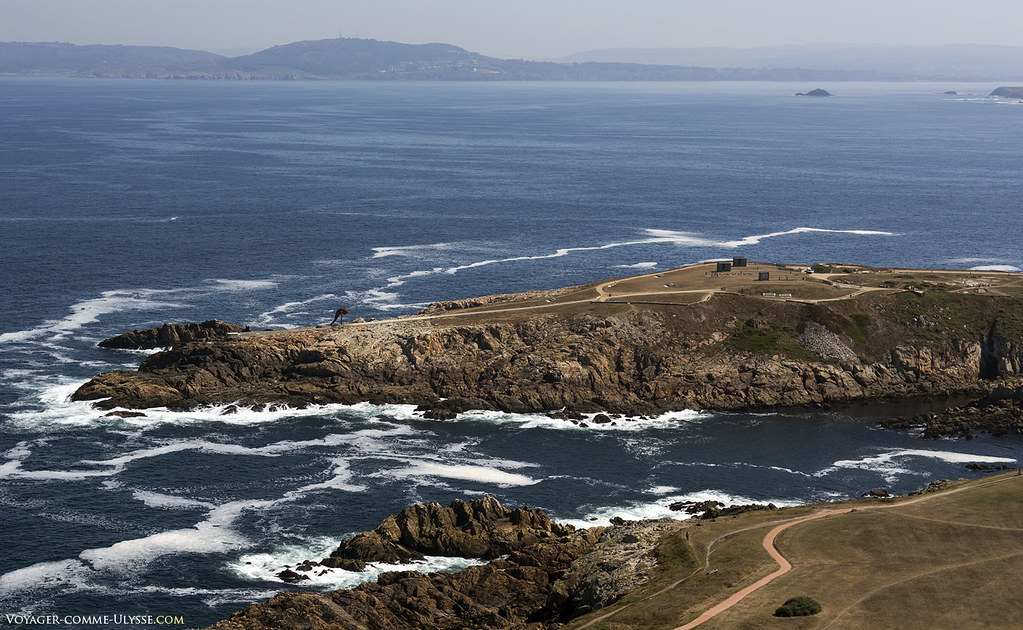
At the top of the lighthouse, you can see the park that surrounds it, and the various walks that have been appointed.
The original tower had above its square base a rotunda. The new tower restored by Giannini, as we can see today, has an octagonal tower that surmounts the large square base and a smaller round tower. Changes to the Tower of Hercules are recalled to our remembrance with bronze bas-reliefs that we can enjoy in the two entrances in the base of the lighthouse.

Solid bronze gate with over it the bas-relief of the tower.

The two bronze doors at the base of the lighthouse.
Tower of Hercules today
30 seconds in front of the Tower of Hercules
In 2009, UNESCO recognized the Tower of Hercules as a “world heritage”, turning it into an invaluable global monument. Although the lights are less useful today, the Tower of Hercules always keep its unique historical value, a Roman monument in an area that was considered at the time of its construction the “end of the world” or “finis terrae.”
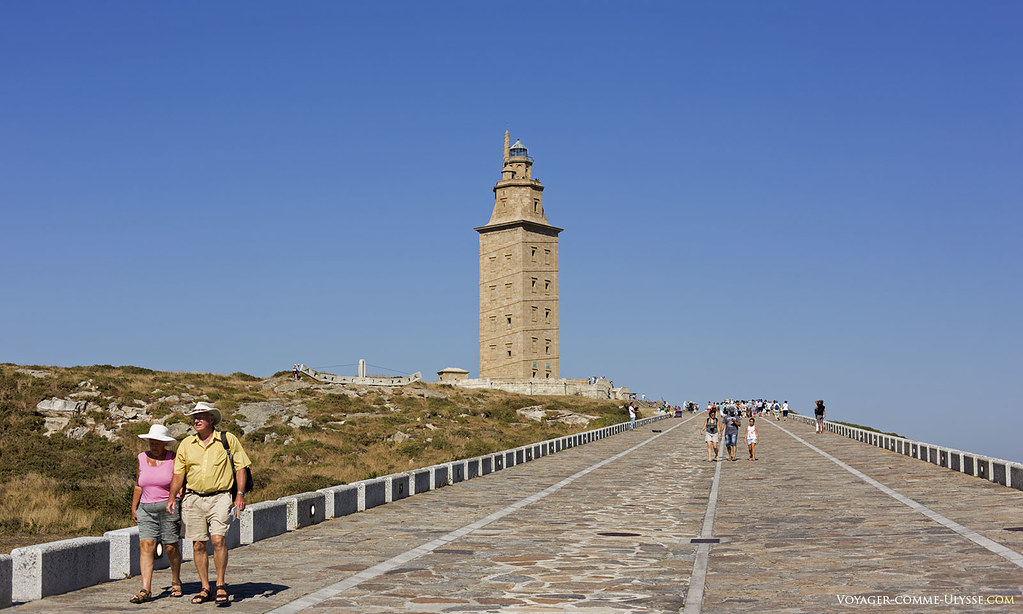
Numerous tourists are always ready to climb the hill to the Tower. Admittedly, access has been arranged.
If one day you sail in this part of the Atlantic, and you are lost, if you see four flashes of white light every 20 seconds, you’re looking at the lighthouse of A Coru├▒a. Every lighthouse has indeed its own visual signature, which allows sailors to recognize the lighthouse they observe.
Pictures of the Tower of Hercules

A basement window, showing the thickness of the walls.

The electric illumination is minimally invasive, with the pipes outside the walls.

Roman quern-stones

Large terrace at the base of the lighthouse, modern era.

Interior staircase of the Tower of Hercules.

Last platform before reaching the top of the tower.

The tower controls the sea, but also what happens in the city.

In the left, one of the windows. In the right, the small spiral staircase to reach the last section before the lantern to the outside.

In the left, for down, in the right, to climb to the lantern. Lantern is closed to the public.

Giannini respected the ancient monument, even in its modern additions. Here, the floor of the octagonal tower added to the square Roman base.

The ceiling of the last turn before the lantern.
 In Aciem
In Aciem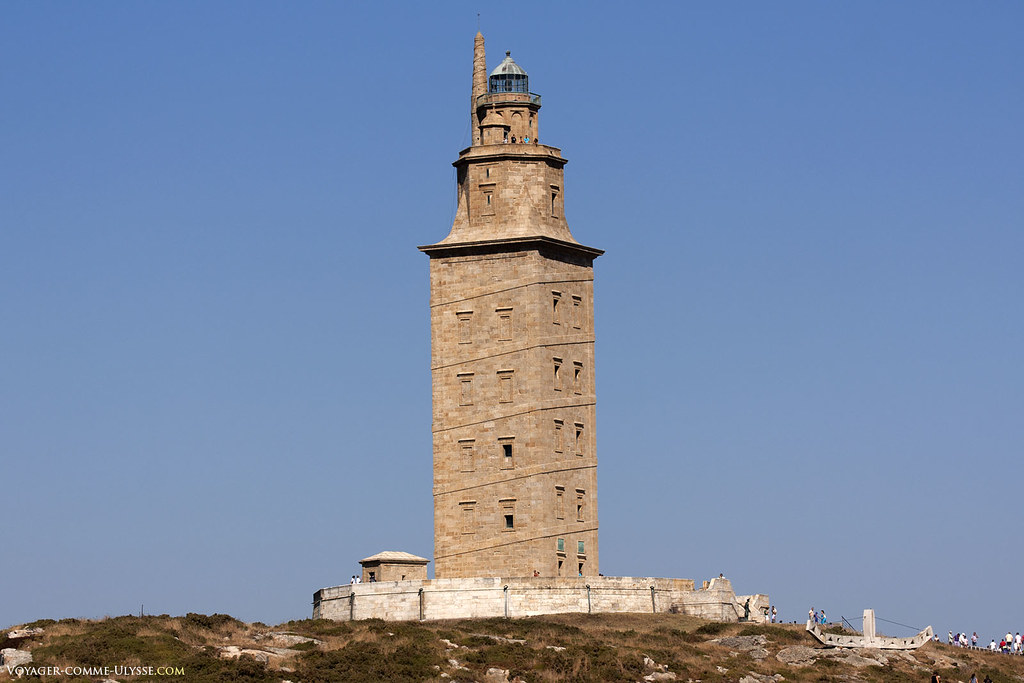

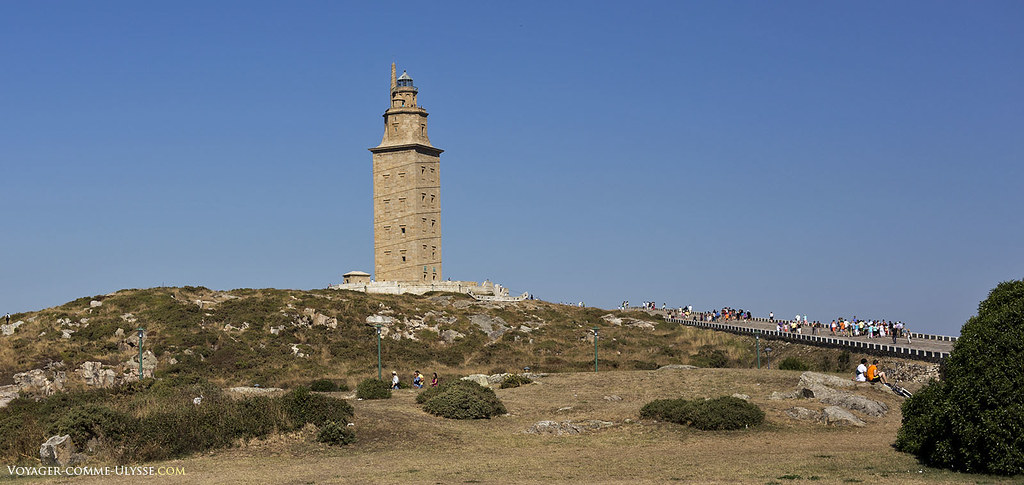

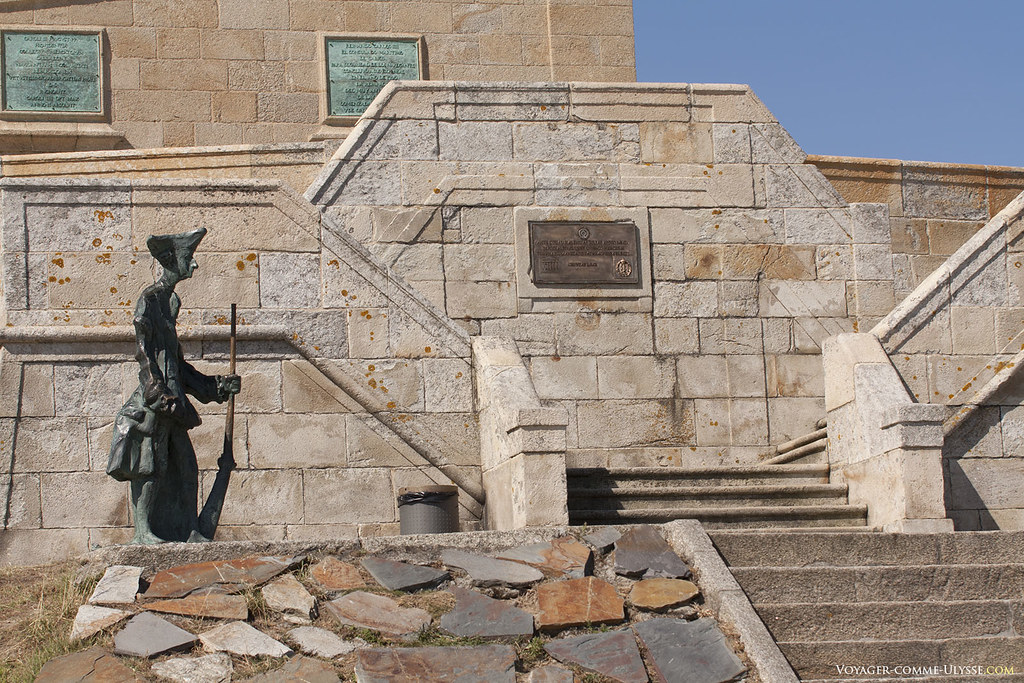
Enjoyed this web site and learned my something new for today! Thank you!
excellent site
do you know who maintains the light? is there a working lightkeeper?
This is fascinating. Thanks for putting this page together. I’d love a chance to visit there sometime.
Your photos are fantastic! How did you manage such wonderful lighting inside the lighthouse? Love all the details you captured. Could you see how near the cruise ship terminal the lighthouse is? We will be walking from the ship (I guess). joyfulwriter@hotmail.com
Ave, Frater,
Your page is very impressive.
As a fan of Roman history, you are probably aware that Hadrians Wall, which people imagine divided Rome from what today is Scotland, was actually in a location which bisected the territory of the Brigantes in modern Northern England and controlled, i.e. taxed, all North-South traffic on the island of Alba (Great Britain). This nation caused so much trepidation that the Romans preserved their name in the word “brigands” = terrifying insurgents or bandits.
Emperor Hadrian, a victorious soldier, thought himself an architect and was said to have visited the wall and its large complex of forts http://www.odysseyadventures.ca/articles/hadrian-wall/article_hadrianswall-forts.htm and made major alterations.
As you indicate, the Tower of Breogan in Irish myth is the location where the supposed “sons of M├şl Esp├íine” (could thus mean soldiers or Romans from Spain?) planned invasion of Ireland. This legend may have been designed explain the origin of the Gaelic language of Ireland, as a migration from Gallicia. Sadly, the Gallician language is extinct, so verification is difficult. Here is a link which attempts a scientific study of this potential Gaelic – Gallician connection by OÔÇśReilly Vazquez http://doras.dcu.ie/16613/
Post script. Can you please delete my first post as it has a fatal error. Merci.